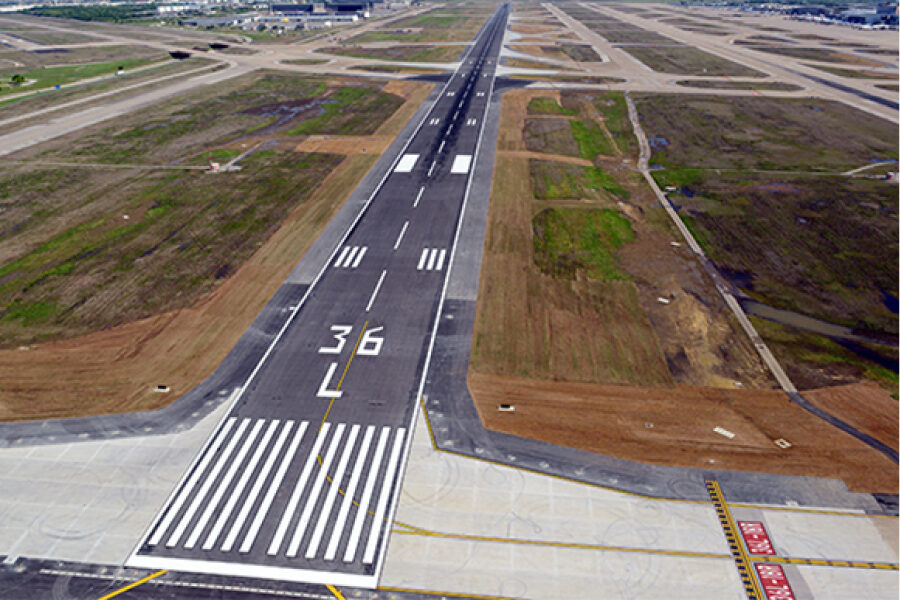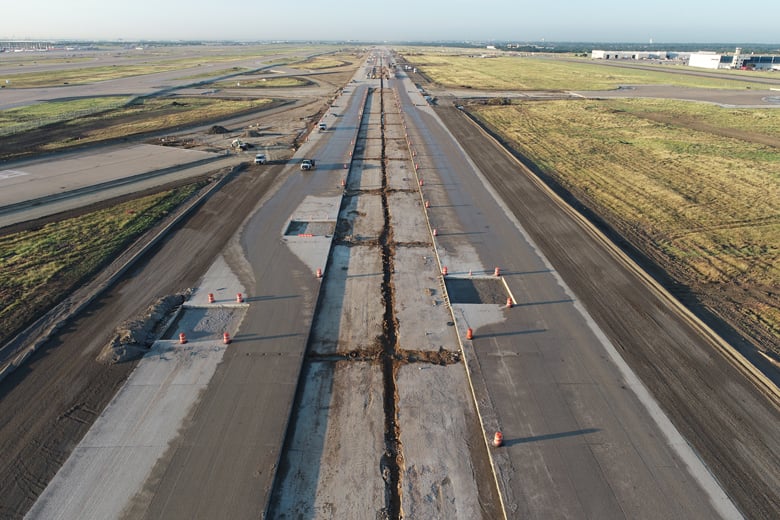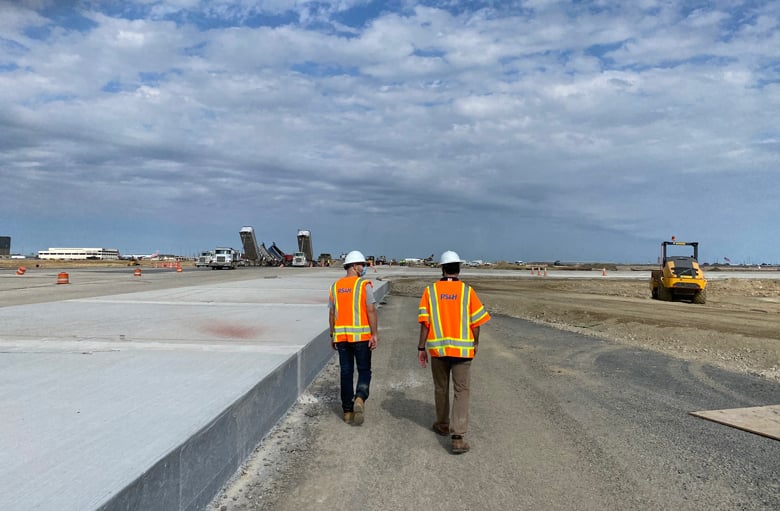Expedited Runway Rehabilitation for Dallas-Fort Worth International Airport

Encompassing over 17,000 acres and seven runways, Dallas-Fort Worth (DFW) International Airport is one of the nation’s largest and busiest airports.
With such an immense and busy airport comes the need for periodic maintenance and repair of critical infrastructure.
In 2019, a pressing rehabilitation need emerged for Runway 18R-36L, which facilitates about 140,000 arrival and departure operations each year. As the engineering consultant selected for the complex undertaking, RS&H was tasked with preparing construction bid documents to repair the runway.
In this role, the RS&H team met the project’s aggressive design and construction schedule while overcoming significant challenges, including the onset of the COVID-19 pandemic. The team even incorporated a first-in-the-state innovation on the remodeled runway.
Working Quickly and Efficiently
Runway 18R-36L, which is more than 2.5 miles long or about the size of 42 football fields, was nearing the end of its economic life. The 17-inch concrete pavement was constructed in 1984 and presented several types of superficial and structural distresses, making it a candidate for complete replacement.
DFW needed the construction to be completed quickly and efficiently, so this primary runway could return to service as soon as possible. As a result, the design and construction time frames were shorter than the norm, but the team met the schedule through significant preparation, collaboration and communication.
“As the designer of record for the project, RS&H was the prime consultant responsible for preparing the construction bid documents and also provided on-site technical services during construction,” said Guiche Batteau, construction support services (CSS) project manager.
In addition to the pavement, numerous other runway elements needed to be rehabilitated, such as airfield lighting and storm sewers. Recognizing the multiple moving parts, the RS&H team approached all aspects meticulously, working closely with specialized sub-consultants and the project stakeholders.
“RS&H led a team of eight engineering consultants that prepared 800 drawings for the original bid package during the fast-track seven-month design phase,” said technical lead Chad Mathes.
The cross-company team held numerous design and phasing charrettes to ensure everything was progressing as necessary.
“We conducted 18 dedicated phasing meetings for the express purpose of creating a construction phasing plan that facilitated the safe operation of aircraft and minimal operational impacts,” said design project manager Elliot Neph.
Considering All Design and Construction Elements
RS&H optimized the design to keep the project on track by tailoring the technical approach to the project budget and schedule.
“Through extensive non-destructive testing, our team determined the existing concrete runway had significant residual structural value,” said Chad. “Overlaying the runway with 195,000 tons of asphalt was a practical strategy that would cost less than complete replacement and would allow the runway to reopen to air traffic faster.”
To address the runway’s severe structural distresses and substandard deflection in some areas, RS&H prescribed a battery of full-depth concrete repairs of some areas prior to the asphalt overlay – with those areas – totaling 34,000 square yards in the keel section and another 9,500 square yards in isolated slabs located elsewhere. In addition, the team installed a retrofit underdrain system and updated the horizontal geometry of 23 connecting taxiways to current Federal Aviation Administration (FAA) design criteria.
The team also considered other elements during design and construction, such as environmental and sustainability goals. In 2019, DFW became the first carbon-neutral airport in the Americas by reducing its emissions and energy usage.
In support of DFW’s environmental stewardship, RS&H came up with environmentally sustainable solutions, like recycling construction waste and installing infiltration strips to improve water quality.
“The aggregate base used to rebuild the shoulders was created on-site by crushing waste concrete generated by slab repairs on the runway,” said Chad. “The hot mix asphalt used to rebuild the new shoulders contains 20% recycled asphalt millings like those generated by demolishing old shoulders.”
Additionally, RS&H helped to elevate the safety of the runway, leveraging innovation to reduce the risk of planes hydroplaning in the rain. The RS&H team specified patented saw-cut grooves with a trapezoidal shape, wider at the top than the bottom, for the runway surface.
This unique groove shape improves safety by increasing water flow, lowers maintenance cost by reducing rubber build-up and extends the pavement life by improving the durability of asphalt applications. This is the first application of trapezoidal runway groove technology in Texas.
Overcoming Complex Challenges
The project began before the COVID-19 pandemic hit. However, several questions began to unfold once the virus emerged.
“Our client considered postponing the project and eventually decided to conduct an extensive value engineering exercise to de-scope about $10 million of proposed improvements,” said Chad.
Every project element was analyzed to determine which improvements should be delayed, expedited or paused. RS&H worked with DFW and the contractor to identify potential cost reduction measures.
During the process, the team identified creative solutions that enabled nearly all planned improvements to remain in the contract while achieving the target cost reduction.
That was good news for all involved. With DFW still busy during the pandemic, repairing the runway and returning it to service as soon as possible was critical to maintaining the airport’s operations.
“I’m glad we are on track to get the runway completed on an expedited timeline with meticulous planning and innovative engineering, despite the obstacle of COVID-19,” said Elliot. “It’s been a great experience working with DFW.”
Learn how our aviation experts can provide timely and innovative solutions for your next airport project.
Top photo credit: Dallas Fort Worth International Airport




